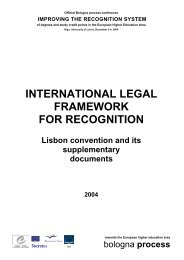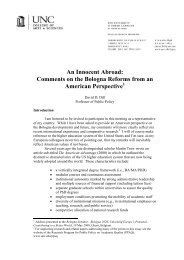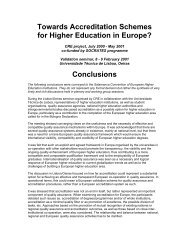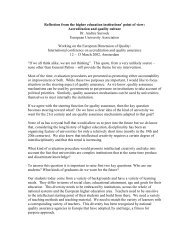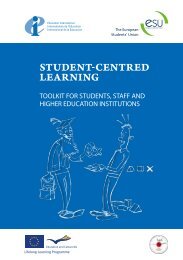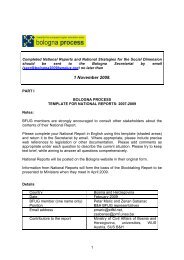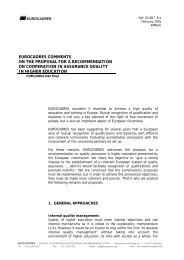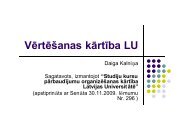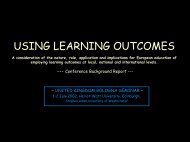EUA Survey Of Master Degrees In Europe - European University ...
EUA Survey Of Master Degrees In Europe - European University ...
EUA Survey Of Master Degrees In Europe - European University ...
Create successful ePaper yourself
Turn your PDF publications into a flip-book with our unique Google optimized e-Paper software.
9 Employabilityindustries, they are relevant beyond the business schools. There is therefore also scope forcoordination at national level. Sweden’s Knowledge Foundation is leading an initiative to drawemployers into collaborative curriculum design associated with the new generation of two-year<strong>Master</strong> degrees. The intention is to identify and foster synergy between employers’ interests andresearch undertaken in the HEIs, with a particular focus on the non-science disciplines, which in thepast have received less attention from the point of view of knowledge transfer.Gender and employabilityThe ‘<strong>Master</strong>’ designation is hardly gender-neutral. <strong>In</strong> 2005, ESU (at that time ESIB) noted that agender bias was also visible in recruitment to the <strong>Master</strong>. <strong>In</strong> its view, the implementation of theBologna cycles coincided with a restriction of access to the second cycle by women. The 2007edition of Bologna with Student Eyes deepened the analysis. Access to the <strong>Master</strong> from the Bacheloris impeded in many countries, it said, by factors such as quotas, tuition fees, shortfalls in fundingto institutions and in financial support for students, and by inequities associated with binary HEsystems.But in fact, it is not easy to see from the data provided how these are expressed in terms of gender. <strong>Of</strong>the eight countries surveyed, evidence of imbalance unfavourable to women at <strong>Master</strong> level appearsto be present in four (Austria, Germany, Liechtenstein and Switzerland); in three the imbalance isfavourable (Denmark, Finland and Spain), and the remaining country (Slovakia) is neutral.The <strong>Europe</strong>an Commission’s fifth Report on Equality between Women and Men (2008), citingthe 2007 Eurostat labour force survey, shows that 80.7% of women in EU27 completed uppersecondary school studies, against 74.8% of men. Similarly, 10.4% of women in the 25-64 age rangewere participating in lifelong learning at the time of the 2006 survey, against 8.8% of men. AtBachelor level, women represent ‘as much as 59%’ of graduates. At tertiary level overall, accordingto Eurostat’s 2007 statistical portrait of the EU, the percentage of women students in EU-25 hadrisen from 52.7 in 1998 to 54.8 in 2004.As far as the doctorate is concerned, Laudeline Auriol’s 2007 report for OECD, which coversArgentina, Australia, Canada, Germany, Portugal, Switzerland and the US, shows that in Germanywomen represented only 32.2% of doctoral enrolments (2004), while in Portugal the figure was39.2% (2005). <strong>In</strong> her own-initiative report on ‘Women and Science’, <strong>Europe</strong>an Parliament MemberBritta Thomsen states that women ‘earn 43% of EU doctoral degrees’. This is a 2003 figure for EU-25, culled from the <strong>Europe</strong>an Commission’s She Figures. She Figures also shows that in the four yearssince 1999 female doctorates had increased by 7%, as against a growth rate of 2% for males.Data on the <strong>Master</strong>, however, is unavailable. As indicated above, relevant Eurostudent, EU and OECDdata sets, which use ISCED 5, cover Bachelor and <strong>Master</strong> qualifications without disaggregation.The situation regarding the <strong>Master</strong> is therefore obscure. Are fewer women gaining entry? Andis this why their access to the doctorate is lower? Do <strong>Master</strong>-level admissions follow traditionallygendered disciplinary pathways? The <strong>Europe</strong>an Commission’s Key Data for 2007 notes that malestudents predominate in science, mathematics, computing and engineering, manufacturing andconstruction, while women outnumber men in the arts, education and health studies. But theseconclusions derive from aggregated data for the year 2003-04. ESU rightly calls for better and morecomprehensive data collection.60



